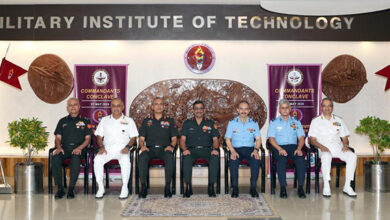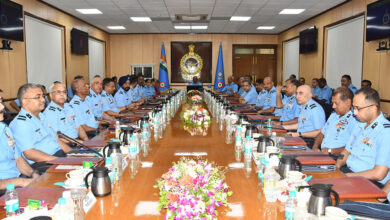Boeing offers Chinook helicopters to India
Philadelphia. Boeing is offering its Chinook CH 47F, the US Army version, to the Indian Air Force (IAF) for multi role missions but Indian forces could go in for specilised variants if they opted to.
 The US Company invited a small group of defence analysts from India recently, including this writer on behalf of India Strategic, and gave them a round of its helicopter production facility here to showcase the technology, engineers and technicians behind its Chinook and V 22 Osprey Tiltrotor and Apache AH 64 helicopters that are mostly or partly made here.
The US Company invited a small group of defence analysts from India recently, including this writer on behalf of India Strategic, and gave them a round of its helicopter production facility here to showcase the technology, engineers and technicians behind its Chinook and V 22 Osprey Tiltrotor and Apache AH 64 helicopters that are mostly or partly made here.
The other facility is at Mesa, Arizona.
The US armed forces have been using the versatile twin-rotor Chinook ever since its deployment in 1966 beginning with the Vietnam War. It’s still the backbone of the US forces in Iraq and Afghanistan.
The Chinook is a multi-mission, heavy-lift assault and logistics support helicopter. Its primary mission is to move troops, artillery, ammunition, fuel, water, barrier materials, supplies and equipment on the battlefield. Its secondary missions include medical evacuation, disaster relief, search and rescue, aircraft recovery, fire fighting, parachute drops, heavy construction and civil development.
In Latin America, it is also used by some private companies to ferry wood logs.
Chinook can be refueled midair to extend its range.
Chinook is capable of literally standing still on a mountain or roof top to drop or pick up personnel, thanks to its powerful contra-rotating tandem rotors that produce a great lift and stability. Several pictures demonstrating this capability have been published worldwide.
Rather than hovering low, the helicopter lands partially on its tail to drop or pick up personnel or supplies.
Chuck Allen, Boeing’s Vice President and General Manager for Rotorcraft Systems, pointed out that although the Chinook looks the same today as it did 40 years ago, “everything in it is entirely new in accordance with the needs and technology that has evolved over the years.”
That’s why, he said, the US has used the Chinooks in hundreds and would continue to do so.
Boeing hopes to keep the production line going through the 2030s, and accordingly, with periodic upgrades and introduction of newer technologies, this rotorcraft could be in service nearly till the end of this century.
 Chuck said that he understood that IAF had a small requirement of about 10 to 12 units initially of this “highly versatile heavy lift machine” and that Boeing was making an effort to participate in the acquisition bid as and when it takes place. “We will offer IAF the best in technology.”
Chuck said that he understood that IAF had a small requirement of about 10 to 12 units initially of this “highly versatile heavy lift machine” and that Boeing was making an effort to participate in the acquisition bid as and when it takes place. “We will offer IAF the best in technology.”
Boeing is in touch with the Indian Air Force (IAF), particularly as there seemed to be an urgent need for the heavy lift helicopters both for military operations as well as humanitarian assistance during unforeseen calamities like tsunami or earthquake.
To cut costs, many of the older machines are being remanufactured for the US forces using a combination of new and usable parts.
Chuck said that the F model was introduced only in October 2006 with an upgraded airframe and new milled, paneled body parts to reduce joints, and thereby vibration as well as inspection and maintenance costs.
All the new Chinook variants have the modern glass cockpit, that is, the control panel consists of several computerized electronic displays that allow a pilot and crew to adjust them and focus on a task that is required most. Every information about a helicopter or an aircraft’s systems and weapons is available on these displays and backup procedures can be activated at the push of a button.
This glass cockpit would have some commonality with cockpits of other Boeing-made aircraft, like that of F-18 Super Hornet, F 15 Eagle, or other helicopters like Apache and V 22 Tiltrotor.
Commonality of parts in different aircraft and systems helps simplify maintenance and reduce inventory costs, and that was why it was practical to use as many common parts as possible, company officials explained.
The glass cockpit is a rather recent innovation, and a tremendous improvement on the traditional bank of mechanical gauges and displays that older aircraft of the Indian armed forces have. Most commercial aircraft, including the three Boeing 737s that IAF is acquiring for VIP use, however do have this sophisticated gadgetry.
Traditionally, Chuck said, Chinooks had been used for combat support and service and disaster relief, it had been strengthened and modified now for infiltration and exfiltration, deep combat assault, and operations in high altitude limited visibility environment.
It can carry 55 fully armed troops or 11,100 kg of weight, inside or under-slung.
The CH 47F is an all weather rotorcraft, capable of performing in high mountain drafts without losing any stability.
The US Army, Air Force, Navy, Marines, Coast Guard and Homeland Security, all the wings of the US armed forces use the Chinook in various roles.





